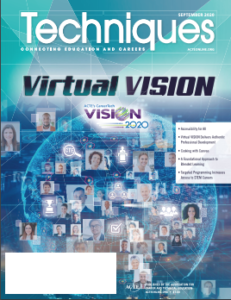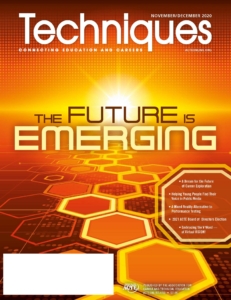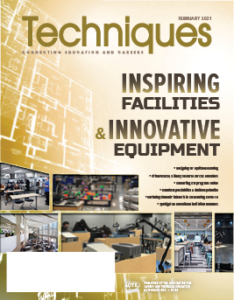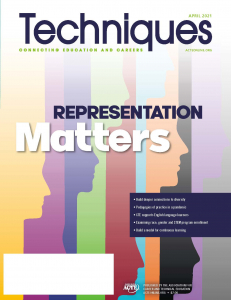Techniques Year in Review: Disruption transforms CTE
Congratulations! Teachers and administrators, you made it through another school year. A hard year. As the COVID-19 pandemic wreaked havoc on schools and communities, ACTE’s Techniques strived to remain consistent. Even as we underwent big changes ourselves.
Techniques diversified its content offerings with a new site launch.
Previously publishing eight print issues a year, Techniques refocused its content strategy to reach the target audience better, more effectively. We launched a dynamic new digital site, on which Techniques released four fully digital issues in 2020–21, alongside four exceptional print issues. Change, while disruptive, brings about growth.
Educators, nonprofit staff and stakeholders, and citizens of a global community, hear these words. To persist and thrive in seasons of disruption:
Meet your audience where they are.
Techniques found career and technical education (CTE) professionals in virtual meeting spaces, outdoor classrooms, simulated labs, and back in school with masks and social distancing.
Look out for the magazine in September.
 LeAnn Wilson wrote: “The show must go on!” Planning for ACTE’s CareerTech VISION was well underway by the time this issue arrived in mailboxes. And readers enjoyed a first look at the immersive networking and professional development expected to take place.
LeAnn Wilson wrote: “The show must go on!” Planning for ACTE’s CareerTech VISION was well underway by the time this issue arrived in mailboxes. And readers enjoyed a first look at the immersive networking and professional development expected to take place.
Techniques in September also introduced our new IAED in CTE column. Snehal Bhakta (Clark County School District) wrote about an innovative program to increase enrollment of diverse students in STEM pathways.
- Jill Nerio and Larry Batson (both of Tulsa Tech) shared important resources for leveraging technology to ensure accessibility for all students. “Accessible content is better content for everyone.”
- Get cooking with Canvas! Melissa Ellegood and Christie Nicholson (both of Yuma Union High School District) did, and they’re sharing the ingredients. Check out their recent webinar and read the article too.
Read Techniques online in October.
October 2020 saw the launch of Techniques’ first-ever fully digital issue. Fellows of the Postsecondary Leadership Success Program at ACTE – Sponsored by ECMC Foundation featured prominently. They shared insights on how to support diverse students navigating postsecondary transitions.
Further, Melanie Allen, an IAED Mentorship Program mentor, contributed to a series of articles for Techniques in October. Allen and colleagues Adam King and Shirley Dawson encourage cross-disciplinary collaboration for strong postsecondary outcomes among students with disabilities.
Look out for the magazine in November/December.
 Doug Major wrote: “There has never been a more exciting — and challenging — time to be part of career and technical education. We have the opportunity to work together to reimagine CTE in a post-pandemic world.”
Doug Major wrote: “There has never been a more exciting — and challenging — time to be part of career and technical education. We have the opportunity to work together to reimagine CTE in a post-pandemic world.”
Techniques’ November/December print issue showcased the many ways in which CTE educators empower future generations of the workforce.
- Dave Boardman (Mid-Maine Technical Center) and Elis Estrada (PBS NewsHour) help young people find a voice in public media.
- Five women leaders reframe negative beliefs associated with women in CTE as they write about embracing aptitudes like vulnerability and virtue as strength.
Read Techniques online in January.
Brian Noller (Northland Career Center) helped kicked off Techniques’ 25th anniversary celebration. In his article, he reflected on how ACTE and Techniques offered integral support for his professional development in CTE. “Techniques and ACTE provide members like me with meaningful and relevant articles that ignite effective instruction and school improvement.”
Such encouraging words from Noller led us to look back at Techniques over time. An article published in 2012 wants educators to learn and grow from failure. “When students learn to accept failure, classroom management may improve,” wrote Jamey McIntosh, product marketing manager at Realityworks, Inc. “Students and CTE educators, alike, enjoy the opportunity to focus on learning.”
Look out for the magazine in February.
 “High-quality CTE programs must innovate and inspire to engage students.”
“High-quality CTE programs must innovate and inspire to engage students.”
This message resonated through Techniques in February 2021. Themes explored innovative approaches to equitable learning, offering lessons for successful integration of academic, CTE and community-based programming.
- The new Dover High School in Dover, New Hampshire, is designed to be a community building. This feature written by Tina Stanislaski (HMFH Architects) tells a modern learning story of innovation in CTE.
- Rasha ElSaheli-Elhage (Chicago State University) challenges educators to consider a mindset shift. Discover valuable tips for approaching online teaching with confidence to meet the needs of students with IEPs.
Read Techniques online in March.
CTE educators make learning fun! Nicole Graves and Patrick Hales (both of South Dakota State University) offer recommendations for gamifying the family and consumer sciences classroom. For Techniques in March, they wrote: “Games motivate students, helping them learn course content while also developing critical relationship skills.”
CTE theatre programs build confidence, self-awareness and empathy. Read Felicia Latoya Brown’s article, which appeared in the March digital issue of Techniques. And discover how this emerging pathway at Trenton Central High School adapted in response to the needs of its students. “Though the school was not able to produce a musical, CTE theatre developed an online production by June of 2020.
“They did another in October of 2020 and an audio-only radio play in December 2020. We produced more theatrical works within the pandemic than we had before it.”
Look out for the magazine in April.
 As a global economy expands further, consider your role and responsibility to improve representation in education. The April 2021 issue of Techniques featured articles from educators and CTE stakeholders designed to inspire reflection as well as action. We must confront vast systemic inequities to design more equitable learning opportunities
As a global economy expands further, consider your role and responsibility to improve representation in education. The April 2021 issue of Techniques featured articles from educators and CTE stakeholders designed to inspire reflection as well as action. We must confront vast systemic inequities to design more equitable learning opportunities
- The Center for Global Education at Asia Society encourages readers to build deeper connections to diversity. Their research proves that a diverse workforce is more productive and happier overall.
- Elina Martinez Medina (Denver Public Schools) shares a personal connection to CTE and English language learning. Her article emphasizes the need for rigorous, content-based instruction to be scaffolded to support all learners. “Shared strategies and intentional instruction are critical for English language and career development.”
Read Techniques online in May.
The future has arrived. Students of today have begun to envision a world where hospitals will grow new organs for patients using their own cells. The May 2021 digital issue of Techniques cast a spotlight on health sciences education.
“CTE classrooms offer an ideal structure to introduce students to career opportunities in biofabrication,” wrote Amanda Bastoni, educational research scientist at CAST. “CTE students learn career skills like lab safety and time management. And they engage in hands-on, problem-based learning related to the workplace. Plus, biofabrication is multidisciplinary with a variety of career opportunities.”
Additionally, Constance Haan (Billings Career Center) emphasizes the importance of embedding quality improvement and patient safety (QIPS) lessons in health science courses. Deepen students’ learning. While QIPS tools improve patient care and outcomes, they can also “apply to personal and professional goals.”



